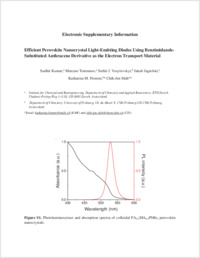Efficient perovskite nanocrystal light-emitting diodes using a benzimidazole-substituted anthracene derivative as the electron transport material
- Kumar, Sudhir Institute for Chemical and Bioengineering, Department of Chemistry and Applied Biosciences, ETH Zurich, Switzerland
- Marcato, Tommaso Institute for Chemical and Bioengineering, Department of Chemistry and Applied Biosciences, ETH Zurich, Switzerland
- Vasylevskyi, Serhii I. Department of Chemistry, University of Fribourg, Switzerland
- Jagielski, Jakub Institute for Chemical and Bioengineering, Department of Chemistry and Applied Biosciences, ETH Zurich, Switzerland
- Fromm, Katharina M. Department of Chemistry, University of Fribourg, Switzerland
- Shih, Chih-Jen Institute for Chemical and Bioengineering, Department of Chemistry and Applied Biosciences, ETH Zurich, Switzerland
-
2019
Published in:
- Journal of Materials Chemistry C. - 2019, vol. 7, no. 29, p. 8938–8945
English
Colloidal nanocrystals of organic–inorganic hybrid perovskites (OIHPs) are an emerging class of solid-state lighting materials owing to their outstanding photophysical properties. Considerable research efforts have been devoted to the fabrication of high-performance light-emitting diodes (LEDs) based on these materials, including interface engineering which is essential for balancing the electron and hole injection in devices. Here, we report efficient perovskite nanocrystal LEDs based on a new electron transport material (ETM), 9,10-bis(N-benzimidazolyl)anthracene (BBIA), possessing a high electron mobility of 4.17 × 10−4 cm2 V−1 s−1 at an electric field of 105 V cm−1. Compared to control devices based on the ETM 2,2′,2′′-(1,3,5- benzinetriyl)-tris(1-phenyl-1-H-benzimidazole) (TPBi), BBIA-based devices exhibit a nearly two-fold enhancement, increasing the current and external quantum efficiencies from 6.25 cd A−1 and 1.51% to 12.2 cd A−1 and 2.96%, respectively. In addition, a small degree of efficiency roll-off of 8 ± 1% at a luminance of 2000 cd m−2, as well as a low turn-on voltage of 2.35 V, has been demonstrated. The anthracene-based compounds may open up new research opportunities for interface engineering in perovskite LEDs.
- Faculty
- Faculté des sciences et de médecine
- Department
- Département de Chimie
- Language
-
- English
- Classification
- Chemistry
- License
-
License undefined
- Identifiers
-
- RERO DOC 326955
- DOI 10.1039/C9TC02352F
- Persistent URL
- https://folia.unifr.ch/unifr/documents/308090
Other files
Statistics
Document views: 124
File downloads:
- pdf: 264
- Supplementary material: 150

